 Home
Actueel
Visie
De 7 fasen
De Esoterische Evolutie
Boeken
Artikelen
Verwante teksten
Tegenkrachten
Over Margarete
Quotes / Test
Links / contact
Home
Actueel
Visie
De 7 fasen
De Esoterische Evolutie
Boeken
Artikelen
Verwante teksten
Tegenkrachten
Over Margarete
Quotes / Test
Links / contact
|
Esoteric Evolution - 16The Androgynous Human Being in Antiquity and ParadiseHalfway through Lemuria, the time we have come to know as Paradise and about which Genesis 2:8 speaks in the Bible, some most fundamental changes developed, changes that had tremendous consequences for the further evolution of the human being and the earth. What were those changes? In the first place, there was the huge event that the Moon separated from the Earth. In addition, in the androgynous human being of the time, a process began that gradually led to the existence of two sexes, male and female. Thirdly, because of the luciferic temptation by the serpent, evil gained access to the human being. This chapter is about the androgynous human being, the human being who has the characteristics of both sexes in one. The book of Genesis in the Bible describes them. Insight into androgyny helps us better understand the separation into two sexes, the subject of the next chapter. The situation before the descent of the IFor now, we return to the time in Lemuria when the "six-day work" of the seven Elohim was completed, but the dripping-in of the human I into the corporeal sheaths (astral, etheric, and physical body) guided by Yahweh-Elohim (Genesis 2:7) had not yet taken place. Moon and Earth were still together and becoming humanity was still androgynous. It is important always to realize that at that time our current earthly structure with its solid, mineral component parts did not yet exist. Everything was to some extent still fluid and in movement, while the temperature was very high. There was no firm soil and no bedrock. Similarly, bones had not yet formed in animals and humans. The becoming human beings had the form of a kind of airy/fluid/jelly-like fish/bird/reptile, and moved in a kind of swim-bubble, swimming and floating through the still thick, fluid substance of the earth. In this situation they sucked up food from the surroundings. They had not yet any lungs, because the elements of air and water had not yet been separated from each other, and therefore there was not yet any pure air.
Nourishing natureThe fluid element in which human beings moved consisted of a protein-rich, milky substance. This milky substance - which originated from the plant realm at the time - contained all the nutrients that were needed. In this way becoming human beings received what they needed. We may justifiably say that human beings then drank from the breasts of Mother Nature. A paradisal picture.1 This original way of feeding themselves was later brought to expression in the statue of Artemis, the goddess of the hunt and fertility, that stood in the mystery center of ancient Ephesus. The front of her body was covered by many breasts. This expressed the abundantly generous and nourishing power of nature as it existed in the earliest times of humanity. Even in our time we still find this nourishing, milky substance, and even now it has a big role in our life. We find it not only in the milky sap of ancient plants like milkweed and dandelion, but also in the mother's milk of female humans and animals who from their breasts give their newborn young the nourishment they need.
The androgynous human being and fertilizationAs Genesis 1:27 says, in that paradisal sphere the ancestors of the human being - created male and female - had both sexes in them, without differentiation. Without differentiation means that both the female and the male element were present in the one body, but in a mixed form. For that reason, procreation was at that time not yet an external event as it is now, but something that happened entirely within one body. We speak therefore of self-fertilization from inside or asexual or virginal procreation.2 As was mentioned before, this old form of procreation took place through nourishment. How should we picture that? Rudolf Steiner tells us that the milky sap with which human beings then fed themselves had at certain times the power of fertilization in it.3 Those times came when the sun and the moon forces that were still working in the earth, stood in a certain relationship to each other. At such moments, the pineal gland, which at the time stuck out of the head like a kind lantern, registered differences in warmth and lighted up.4 That was the sign that fertility existed. As they were eating, the becoming human beings were in that period fertilized by the nourishing sap. The spiritual world was closely involved in this sexless procreation.5 At those particular times, when sun and moon stood in a particular constellation relative to each other, high spiritual beings from the angelic hierarchies descended to human beings, overshadowed them, and thus caused fertilization to take place within the body so that they gave birth to their equals. We find a picture of asexual, virginal procreation through self-fertilization and the role in it of the spiritual world, in ancient Egypt where the goddess Isis was fertilized from the spiritual world by a sunbeam of the godhead Osiris. The role of sun and moonEven in our time we can still find remainders of this ancient way of fertilization and procreation in which sun and moon play a role, notably in sea creatures in warm, tropical seas. On the island of Bonaire in the Caribbean, for instance, the sea coral massively spawns every year in September, seven days after the full moon, three hours after sunset. Here we see again the connection between the season and the position of the sun and moon that makes fertilization possible. The skin of the coral creatures contains temperature- and light-sensitive cells that perceive changes in the season, moon cycles, and the rhythm of day and night with the greatest accuracy.6 In human beings we also find the connection between moon and fertility, namely in the cycle of women. Just as the moon cycle from one full moon to the next, the female cycle is one of 28 days on average. In the middle of that period, ovulation takes place. That is the time when the woman is most fertile. Later, we will come across additional examples of the connection between the sun- and moon forces and procreation.
The androgynous human being was more female than maleIn the ancient mysteries the deep secrets in the relationships between the sexes and procreation had always been known. They knew, for example, that androgynous human beings looked more like women than like men, a fact that Rudolf Steiner confirmed. In the original human being, he said, we are witnessing an androgynous individual who inclines to the female side. This individual bore in itself both the fertilizing element and the element to be fertilized. In other words, "woman" had "man" in herself.7 Because of this, since human beings inclined to the female, they could be fertilized from inside, from their own body. Only after the separation of the sexes the male sex comes to the fore.
Now, some people may ask: "But the Bible says something very different, right? When we read Genesis 2 and 3, we come across the name Adam. Doesn't that mean that the first human being was male?" The problem lies in the translation of the Bible. When we compare different translations of the Bible, we see that some of the (older) ones have translated the Hebrew word We get a different view from the official Dutch Bible translations of 1951 and 2004/2007. In these the name Adam does not appear at all in the first three chapters! Wherever in other translations "Adam" appears, these newer translations rightfully use the term "human being." According to esoteric knowledge and to Rudolf Steiner, that is the one and only correct translation of the Hebrew word In other words, in chapters 1-3 of Genesis, no particular sex of "the human being" is spoken of. Even in the contact with Eve the words used are asexual: "the human being." Only in Genesis 4:1 and later in Genesis 4:25, when there is mention of sexual intercourse, the name Adam is used: "And Adam knew his wife again…" (Genesis 4:25). But in the meantime, we have arrived at the time when the separation of the sexes was happening, and fertilization takes place from the outside. Hence only here does the male sex act under the name of "Adam," the man who makes Eve pregnant. The uniformity of the offspringIt is important to know that in the time before the separation of the sexes, when the becoming human being procreated in an asexual, virginal way, there existed not yet any differences between human beings. As Rudolf Steiner said, they gave birth to "their equals." That means that the offspring of androgynous human beings were exactly like each other, uniform, and in appearance inclined to the female. They not only looked like each other, but also like their ancestors, even in character.8 In other words, in those times there was not yet such a thing as genetic diversity or individual differences. That only came after the separation of the sexes. But still, depending on the spot where the ancestor of the human being was, by influences from the environment, from the outside therefore, a very light form of difference did also take place. This was possible because at the time the soft corporeality was very receptive to what came to it from the environment. However, when corporeality and the general sphere became denser due to increasing hardening and, as a result, the becoming human being became more isolated from the environment, this came to an end. It was clear: if the individual aspect of the human being was to grow and develop - prerequisite for becoming a spiritually self-aware human being in the future - something more was needed. An individual I, for example, as well as, as we will see, separation of the male and female sex. Androgynous animalsIn the animal kingdom too, we still find remnants of androgyny and virginal procreation. Also in them, their androgynous offspring gives birth to "their equals," that have a female aspect that still has the male in it. Examples are the Indian stick insect, some beetles, and aphids, but also some lizards, salamanders, and snakes.9
The reason why they are androgynous is that the ancestors of these, from an evolutionary point of view, lower animals separated out of world corporeality before the separation of the sexes had happened. In this connection it is interesting to know that androgyny in the above-mentioned sense does not commonly occur among the (higher) mammals. At best as an exception. That is logical if we realize that they only developed in evolution after the separation of the sexes. Sources
© Margarete van den Brink 2007-2025 - www.margaretevandenbrink.nl
|



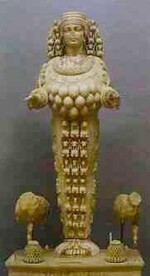 The goddess Artemis in Ephesus
The goddess Artemis in Ephesus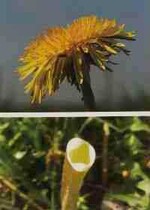
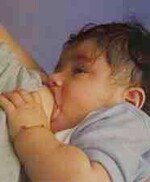
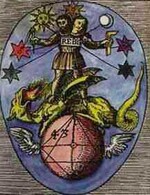
 , adam with Adam. That created the impression that the first human being was male. The name indicates it.
, adam with Adam. That created the impression that the first human being was male. The name indicates it. , adamah, which means "he who was taken from the earth." Properly translated, the word "Adam" thus indicates nothing more than a human being who was taken from the earth. Or speaking in the style of our subject of the evolving human being, we could say "the human being whose body was built up from becoming earthly materiality."
, adamah, which means "he who was taken from the earth." Properly translated, the word "Adam" thus indicates nothing more than a human being who was taken from the earth. Or speaking in the style of our subject of the evolving human being, we could say "the human being whose body was built up from becoming earthly materiality."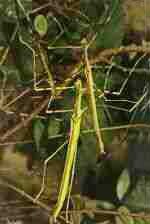 The stick insect
The stick insect


